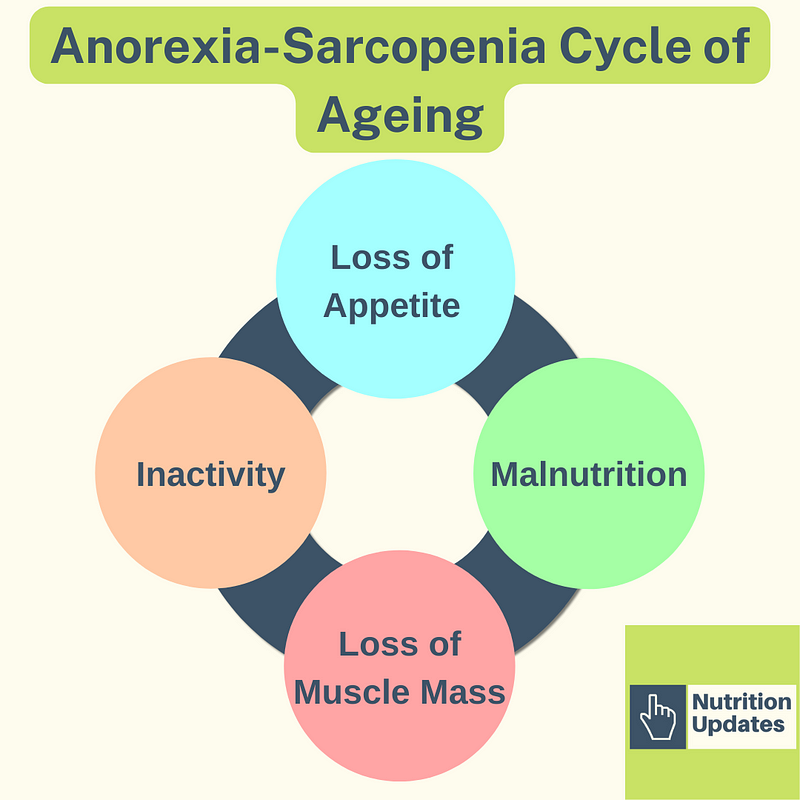Breaking the Cycle of Anorexia and Sarcopenia in Older Adults
Written on
Chapter 1: Understanding Anorexia and Sarcopenia
As we grow older, our bodies experience a decline in muscle mass, bone density, and metabolic rates. This often leads to a reduced appetite, a phenomenon referred to as the anorexia of aging. The interplay between anorexia and muscle loss creates a detrimental cycle: decreased appetite leads to reduced food intake, which in turn contributes to muscle loss. This excessive loss of muscle is termed sarcopenia, which can result in significant health risks, including a 60% higher chance of falls and a 71% increased risk of fractures in comparison to older adults without sarcopenia.

Chapter 2: Breaking the Cycle
Recent studies indicate that early identification and treatment of anorexia could disrupt this harmful cycle, enhancing the quality of life for older individuals.

Exercise as a Solution
Engaging in regular exercise has been shown to stimulate appetite and encourage better eating habits in older adults. Not only does exercise contribute to overall health, but it also plays a crucial role in preserving muscle mass and strength. A study involving older adults participating in supervised resistance training demonstrated promising results:
- Participants engaged in two gym sessions weekly, with at least 48 hours between sessions.
- The resistance exercises included seated rows, leg presses, chest presses, leg extensions, lat pull-downs, leg curls, and shoulder presses.
- They completed two to three sets of 10–15 repetitions at 65–75% of their repetition maximum.
Additionally, participants consumed two servings of a 15g whey protein shake daily to support muscle development. After 12 weeks, these older adults experienced an average increase of 1.2kg in fat-free mass and reported consuming an additional 133 kcal/day, along with an 18% rise in appetite ratings.
How to STOP Age Related Muscle Loss (Sarcopenia) - YouTube
This video discusses effective strategies to combat age-related muscle loss and highlights the importance of maintaining an active lifestyle.
The study revealed a correlation between increases in fat-free mass and daily caloric intake. It suggests that rather than merely feeding muscles, they actually create a demand for nourishment. Conversely, a lack of muscle usage leads to degeneration and a diminished appetite, perpetuating the anorexia-sarcopenia cycle.

Considerations for Older Adults
While the research indicates that resistance training combined with protein supplements can effectively break the anorexia-sarcopenia cycle, it primarily involved healthy older adults capable of participating in gym activities. This raises questions about the types of exercises suitable for those with limited physical capabilities.
Moreover, gym-based training poses higher risks for older adults and often requires professional supervision, which can be expensive. However, there is potential for lower-intensity exercises, such as jogging or cycling, to yield similar benefits.
It's important to clarify a common misconception: exercise is not primarily a weight-loss strategy. Instead, it serves to enhance body composition by reducing fat mass while increasing fat-free mass.

The Role of Protein Supplements
Protein supplements, such as whey protein shakes, can be an effective means for older adults to increase their protein and caloric intake. Many seniors struggle to consume sufficient food to meet their nutritional needs, making shakes a more convenient option. Interestingly, while high-protein diets are often recommended for weight loss, simply consuming protein shakes does not guarantee weight loss.
The international PROT-AGE group advises older adults (over 65 years) to consume:
- 1.0g — 1.2g of protein per kg of body weight;
- 1.2g — 1.5g of protein per kg of body weight during injuries or conditions leading to unintended weight loss (such as illness).
The PROT-AGE group emphasizes the need to boost protein intake among seniors to combat sarcopenia, with exceptions for those with existing kidney issues.
Lifestyle Interventions for Age Related Muscle Loss - YouTube
This video outlines lifestyle changes that can help mitigate muscle loss associated with aging, emphasizing the significance of nutrition and exercise.
Conclusions
To effectively disrupt the anorexia-sarcopenia cycle associated with aging, a balanced diet coupled with a consistent exercise regimen is essential. Conversely, if you find yourself with an excessive appetite and excess weight, you may want to explore strategies to minimize the loss of lean mass during intentional weight loss.
